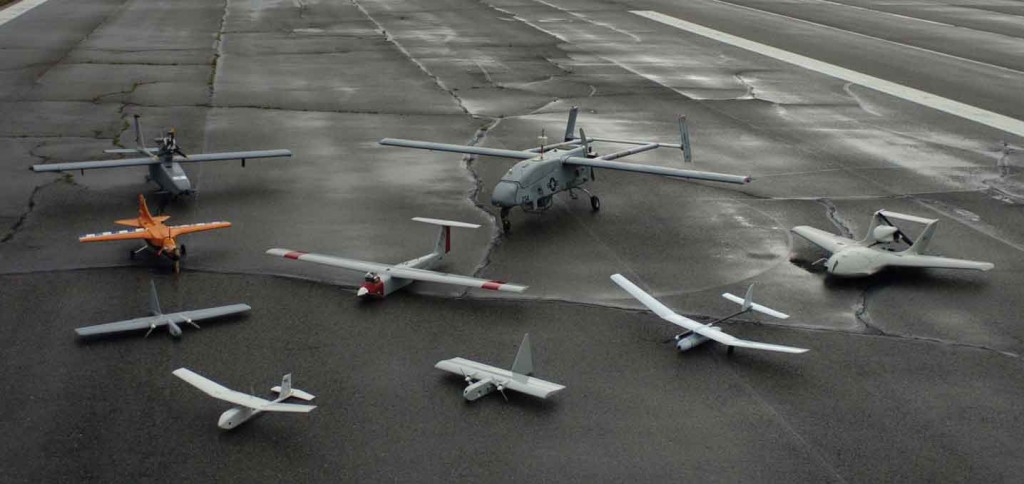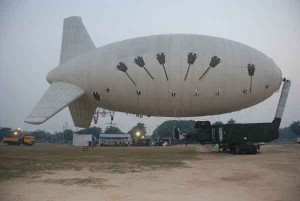
Various Unmanned Aerial Vehicles. Pictured are (front to back, left to right) RQ-11A Raven, Evolution, Dragon Eye, NASA FLIC, Arcturus T-15, Skylark, Tern, RQ-2B Pioneer, and Neptune.
Having celebrated the centenary of manned aviation just eight years ago, it will be time to celebrate the 100th anniversary of unmanned aviation on March 6, 2018. Unmanned aviation encompasses a wide range of airborne platforms, from an ‘aerial torpedo’ or the forerunner of today’s cruise missile to the futuristic astral-planes being developed to explore other galaxies. Other machines include aero models, target drones, decoys, reconnaissance as well as armed platforms; which are commonly known as Unmanned Aerial Vehicles (UAVs). With a variety of dangerous’ missions presently flown by combat pilots both fixed and rotary wing, being taken over by robotic flying machines, the new terminologies with a wider connotation to replace UAVs are Unmanned Aircraft Systems or Unmanned Aerial Systems (UAS).
The development of unmanned aircraft hinged on integration of three critical technologies namely automatic stabilisation, remote control and autonomous navigation. Elmer Sperry of USA was the first to attempt an unmanned aircraft design to incorporate the three features on a single platform. The efforts resulted in the invention of the Aerial Torpedo. Efforts in the US and UK to design radio controlled recoverable aerial targets materialised with a successful flight in September 1924. Target drones were introduced in 1930 as a spin-off of these early efforts. Prior to World War II, target drones were in use in both the countries to train anti-aircraft gunners. Interestingly, some of these were assembled by a 19-year old employee, Norma Jean Dougherty, who later became famous as Marilyn Monroe.
The USAF has initiated a program to develop the Next Generation Unmanned Aerial System (NG-UAS). In May 2009, the industry was notified by the USAF that it seeks a follow-on UAV to the highly successful MQ-1 Predator and MQ-9 Reaper…
In later years, unmanned aviation progressed rather slowly with the USAF using these mainly as reconnaissance drones in the Vietnam War. Although research on miniaturization incorporating inertial navigation GPS and data-link continued, it was the Israel Defence Forces that were the first to exploit these capabilities. In the Yom Kippur war of 1973 in the Golan Heights, Israel used UAVs to obtain critical information on the advancing Syrian armour, which helped them to set up ambush and achieve a decisive victory despite numerical superiority of the enemy. However, the true potential of the UAV was understood only after the operations in Bekaa Valley in 1982, wherein the Israelis employed UAVs as “force multipliers” in varied roles such as reconnaissance, spoof missions and Electronic Warfare.
Future Trends
As the Centennial year of UAV approaches, a number of countries have already launched futuristic programmes with advanced technologies are being incorporated for size, shape and payload. The USAF has initiated a program to develop the Next Generation Unmanned Aerial System (NG-UAS). In May 2009, the industry was notified by the USAF that it seeks a follow-on UAV to the highly successful MQ-1 Predator and MQ-9 Reaper, the latter a much improved variant of the Q-1 series. UAVs with the prefix ‘M’ indicating multi-mission capability, proved invaluable in operations in Afghanistan and Iraq.
Then there is the US Defence Advanced Research Projects Agency (DARPA) project to develop the ‘Vulture’, a UAV that would have an enormous endurance of five years. Recent news reports indicate that the development programme has entered second phase. Details of the design or the type of fuel it would use for a five-year endurance are however not available.The NG-UAS platform is planned to have capabilities beyond existing UAVs. Compared to the MQ-1 Predator which first flew in 1994 and the derivative MQ-9 Reaper of 2001 vintage, the new vehicle would have improved manoeuvrability and time-on-station among other features. The planned initial operationalisation of the NG-UAS would be 2015. General Atomics has already developed a candidate for the NG-UAS role now known as Predator-C. This UAV is believed to have swept-back wings and stealth characteristics. Other firms, notably Northrop Grumman, which produces the highly successful RQ-4 Global Hawk UAV as well as several other firms are expected to enter the competition for the NG-UAVs. With all-weather and triple- redundant avionics and 70 hours of endurance, the Israeli UAV ‘Eitan’ holds great promise. Eitan is capable of carrying payloads of 2000 lbs. Solar powered UAVs under development will facilitate long duration stealth flights at high altitudes., Surprisingly Russia has been a somewhat late entrant in this field And nhow has launched an ambitious programme for tactical UAVs.…the proposed supply of 12 Predators to Pakistan has raised concerns in India. Although US officials had mentioned that the Predators would not be armed with Hellfire or other such air-to-ground missile…
The Chinese have made steady progress in this field over the last decade. Over 40 UAV models were displayed at the Zhuhai air-show in mid-November 2010. These included both fixed and rotary wing designs aimed at not only intelligence, surveillance and reconnaissance applications but for strike role as well.
Increasing Combat Role Two years ago after an intense debate, President Obama had agreed to incremental increase in the strength of US troops in Afghanistan. However, what may have gone unnoticed is the manifold increase in the use of Unmanned Aerial Systems (UAS). USAF is using a wide variety of such platforms in Afghanistan for combat-support as well as for remote delivery of PGMs and other weapons, over unsuspecting targets. As regards this big ‘surge’ in Iraq and in Afghanistan in particular of robotic planes, it is reported that there has been a 120 per cent increase in UAS flying as compared to in 2006, Similarly the numbers of Predators and the resultant missile attacks have also grown exponentially.
The reach and lethality of UAVs are such that the proposed supply of 12 Predators to Pakistan has raised concerns in India. Although US officials had mentioned that the Predators would not be armed with Hellfire or other such air-to-ground missile, it will not be too difficult for Pakistan to do so with clandestine assistance from another source. Pakistan already has ongoing UAV development projects with China, Turkey and South Africa.
The US has now offered Pakistan the smaller Scan Eagle UAV, which has a longer endurance. It weighs 18 kg , has a three metre wingspan and uses a new video technology (Pixon Vision) that provides better resolution. The Scan Eagle can stay in the air for up to It has an endurance 15 hours and fly as high as 5,200 meters. The aircraft carries an optical system that is stabilised to keep the cameras focused on the target while the UAV is in flight.
Development of UAVs in India
The Indian Air Force (IAF) inducted the Searcher II and Heron UAVs in the year 2000. These have performed well over the past few years delivering electro optical/infrared (EO/IR), EW and Synthetic Aperture Radar (SAR) intelligence. The IAF has been able to exploit ground and airborne relays to extend operating range and also using them over different terrains including the Himalayas. Op Parakram provided the IAF the opportunity to develop the expertise to reduce ‘sensors to shooter’ cycle. On the other hand, deployment in different parts of the country enabled the IAF to acquire additional infrastructure which will help in exploiting UAV in different roles such as disaster management including detection of leaked radiation as in Fukushima, Japan recently and for internal security. The Indian Army and the Indian Navy have also procured similar platforms enabling commonality in training, infrastructure and maintenance.
It is also estimated that the memory capacity of a computer will equal that of the human closer to 2030. Hence the opportunities of futuristic applications of UAVs are phenomenal.
The IAF has been able to exploit ground and airborne relays to extend operating range and also using them over different terrains including the Himalayas.As regards the indigenous programmes, in early 1980s, the IAF used remotely operated targeting drone Chakor, an improved version of the Northrop Chucker RPV,. However, development of the DRDO derivative Lakshya was delayed. However, with recent modifications to the tow body and the engine, its performance has improved considerably including for practice firing of BVR missiles. On the other hand, another catapult launched UAV Nishant has made good progress with a new Wankel engine. This will pave way to the advanced version Gagan, which will also carry an SAR payload. DRDO has now embarked on a comprehensive programme for varied types of indigenous UAV. DRDO has successfully test flown Rustom-1, a Medium Altitude Long Endurance UAV, the second time in October last year. It has also developed a Micro-UAV named Netra, specifically for anti-terrorist and counter insurgency operations. This 1.5 kg UAV is a collaborative development project between DRDO and alumni of IIT, Mumbai and has the potential to operate in all the conflict theatres, including urban scenarios similar to that of the 26/11 terrorist attack.
Presently the various roles for which UAVs are being utilised by the IAF are intelligence gathering including reconnaissance and surveillance, UAV assisted fighter /helicopter strike (UAFS/UAHS) as well as laser designation of targets. UAVs are also used for Battle Damage Assessment (BDA) and for real time inputs to aircraft on strike missions. Use of SAR and IR gives this platform near all-weather capability. UAVs are also used for ELINT and using the inputs along with COMINT to evade and intercept enemy fighters and helicopters. Other role being considered is a weapon platform like the American Predator, paving way to UCAV in the future.
The unmanned systems acquired by the IAF have been continuously upgraded. Add-ons such as Automatic Take Off and Landing systems, satellite communication data-links, better radio relays and advanced payloads are also being contemplated. It is a versatile platform, a force multiplier and hence it needs to be accorded the necessary impetus for attaining integrated operational status.
It is reported that the US armed forces fly more than 350,000 hours annually on UAV and nearly half the total air effort in Israel is on such remotely operated platforms. With numbers of UAVs on the increase, indigenisation assumes greater importance. India needs to develop capability to develop large platforms like the Global Hawk, stealthy X-47B, armed Predator, SR-30 Rotary and the 6-inch long Micro UAV, Black Widow.
It is heartening to note that not only is the DRDO collaborating with aerospace majors, but the Indian private industry along with foreign partners has also entered this field. Backed by India’s expertise in software, concerted efforts in manufacturing UAV and necessary ground support equipment, would greatly benefit the military and civil users alike. Need of the hour is to get down to serious implementation of the current as well as future programmes. If we do not , it may well be a repeat of other delayed projects like LCA or IJT and we will be shackled forever to imports.
With no possibility of human casualty and marginal investment compared to a manned aircraft, for proving the basic fly-worthiness of the platform; UAV developmental programmes are very cost-effective, some of them being developed in the ‘back-yard workshops’. It is time to use IITs and other technical institutes for innovation and also use private sector industries for marketing.
Moore’s Law predicts that the speed of microprocessors will reach parity with the human brain around 2015. It is also estimated that the memory capacity of a computer will equal that of the human closer to 2030. Hence the opportunities of futuristic applications of UAVs are phenomenal. UAVs will evolve from being remotely operated to independent robots, able to self actualise the task. But such ultimate autonomy will require capabilities similar to the human brain in terms of speed and memory. As to how many lines of software code equate to ‘thinking’ is still not clear, but indigenous capability in Robotics and Artificial Intelligence will need to be developed rapidly so as not to miss out the next RMA.






My son is interested in doing the ” Unmanned aerial vehicle course ” in India. Any suggestions ? Thanks
Thanks for the updates Sir. If some articles on UCAVs can be published.
Dear Sir,
I do fully realise and understand of the above siad facts.
More than anything else our arsenels should be ready with full preperation with constant, susuained and fully dedicated war factors from three major components Air, Army and navy. This must be suitably and preperatually supported, instigated and supported by our para defences like ITBP, BSF and CRF The role of IB, RAW and other local intelligence is also indespensible and imperative.
Preparation depends on regular mopck drill, excercise under various conitions and simulated excercises.
We can be worried but that must not stop our available defense-power.
G Ramani Iyer